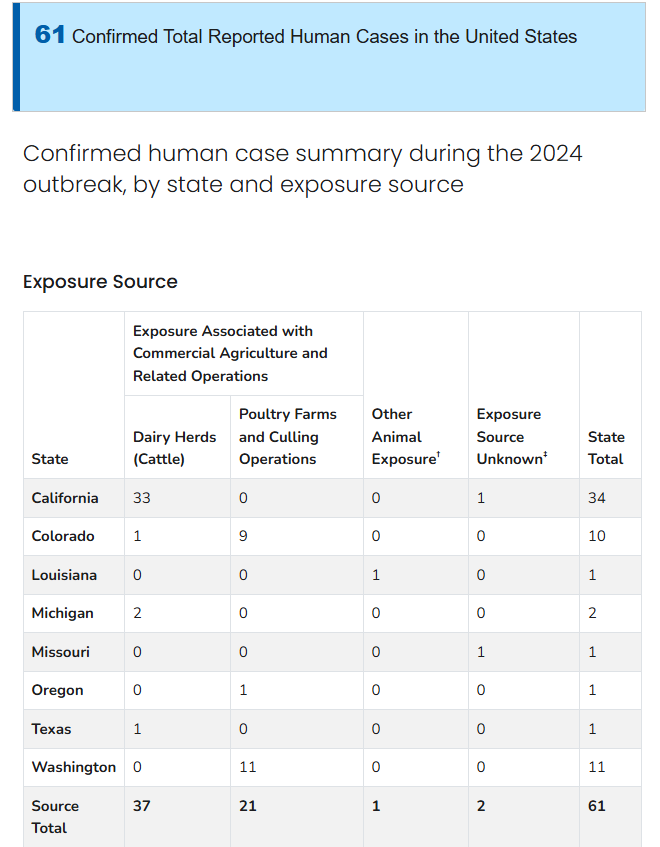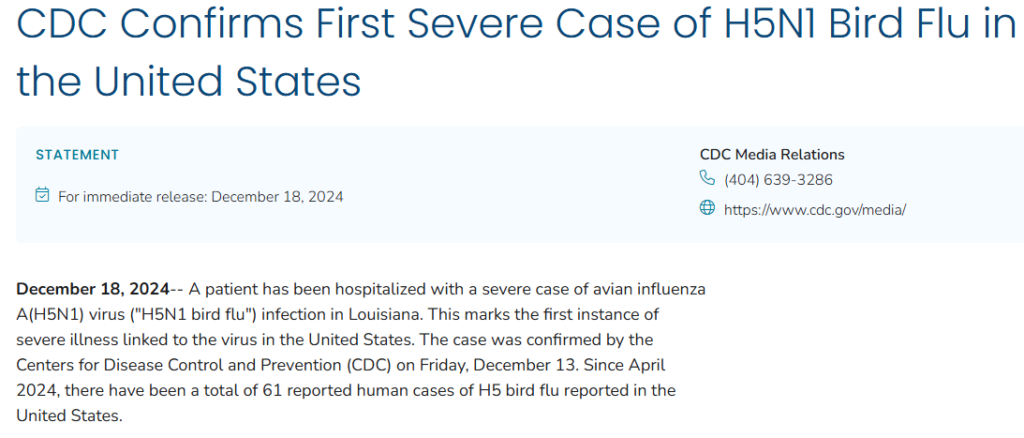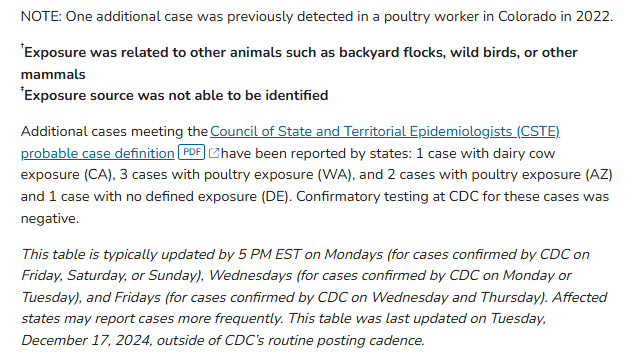In the past week, there have been several developments with regard to H5N1 and human health. We now have a severe case of bird flu in a patient currently hospitalized in Louisiana. We also have a “probable” H5N1 case from Delaware that was mild and not confirmed by the CDC, so it is not included in the official total. Finally, we have another “probable” case in Wisconsin that is awaiting official confirmation from the CDC, which now puts the current total of confirmed H5N1 human cases at 61. Further details on each of these human cases below.

1 Human H5N1 Case in Louisiana (12/23/2024)
On Friday, December 13, a “presumptive positive” human H5N1 case was announced in Louisiana. The patient apparently “had exposure to sick and dead birds that are suspected to have been infected with H5N1″ after which they became ill and are now hospitalized.
Importantly, the CDC announced on the following Wednesday, December 18, that the patient’s case was severe and that the patient remains hospitalized. As noted by the CDC, “[t]his marks the first instance of severe illness linked to the virus in the United States.”

Although there is no further information as to what “severe illness” means, it likely means severe respiratory disease, as in the teenage patient in Canada.
Sequencing showed that the H5N1 virus that infected the patient in Louisiana is genotype D1.1, the same genotype that has spread through wild birds. It is also the same genotype as the severe human H5N1 case in Canada. At the same time however, many of the recent human H5N1 infections in several Western states have also been of genotype D.1.1 and those cases have been mild. But we will be watching this case in Louisiana closely and hope to get more information from the CDC as to the patient’s condition and how they got infected.
Per the CDC, the investigation so far has determined “that the patient had exposure to sick and dead birds in backyard flocks.” So not only is this the first severe human H5N1 infection, it is also the first known instance where a person became infected after exposure to backyard birds.
But what kind of exposure?
In prior years, severe H5N1 infections have been found in people who have close handling of sick or dead poultry, like chickens, or even prepare them for a meal. In Cambodia for example, a fatal H5N1 infection in a 15 year old girl resulted from the girl handling dead chickens found in her village 5 days before her symptoms began.
But for people who just keep backyard flocks, the route to a severe infection seems less clear. For example, an asymptomatic H5N1 case was discovered in a man who kept a flock of ducks in his backyard in England. Was his method of exposure vastly different? Perhaps, or perhaps not, but the difference in severity was very likely impacted by this patient being provided with a a dose of oseltamivir as a prophylactic. Before he was infected, this Englishman had reported a noticeable increase in deaths amongst his ducks, and upon testing the flock was confirmed to be infected with H5N1. So given his clear risk, as he “had been exposed to infected birds and their secretions” without PPE, the medication probably worked well in his favor.

The role that wild birds have played in spreading H5N1 cannot be understated. In the past few weeks, H5N1 has been again moving with wild birds infecting flocks throughout the country.
Indeed, on December 10, Louisiana reported die offs in wild bird populations from the virus. The uptick in wild waterfowl deaths is linked to fall migration of wild birds that cross the Mississippi flyaway, in which Louisiana is located. So it wouldn’t be surprising that poultry farms or backyard flocks that lie in that same path would come in contact with some of these infected migratory birds, thus becoming infected themselves. What is surprising here is that such resulted in a severe H5N1 case in a human, who presumably was infected by his/her sick backyard flock in some way.
To be sure, the contemporary version of H5N1, clade 2.3.4.4b, has shown a remarkable ability to spread far and fast, through more species of birds and mammals than we have ever seen, and has caused more than 60 human cases in the U.S. when before two years ago there had been none. It shouldn’t be easy for a person to get H5N1, let alone a severe case of H5N1, directly from birds. I hope the investigation is more successful here than the one in Canada, which never gave a definitive answer. Knowing exactly what activities or actions led to this person in Louisiana being infected may inform additional public health guidance for people who have backyard flocks, as this H5N1 virus has gotten much more efficient at transmitting between wild birds and semi-domesticated birds.

1 Human H5N1 Case in Delaware (12/17/2024)
Another “probable” human case of H5N1 was reported in Delaware during routine flu surveillance, according to news reports. The state’s division of public health confirmed an H5 (novel flu strain) result.
As reported in an article by BNO news, a communications official from the state’s division of public health stated that this patient had “no known exposure to infected animals” and had “no links to dairy or poultry facilities.” So with no (known) exposure to the typical routes of H5N1 infection, how did this person test positive for an H5 virus?
Further, as reported by CIDRAP, the CDC notified the state health authorities that it could not confirm the novel flu result. Therefore, the Delaware case remains one of many “probable” cases listed on the CDC’s website, where a state lab test results in an H5 virus detection but for some reason the CDC can’t officially confirm that result.
This is becoming more common it seems, as there are now 7 cases that the CDC lists as “probable”. This unconfirmed/probable H5N1 case count consists of: 1 case from California with exposure to dairy cows, 3 cases from Washington State with exposure to poultry, 2 cases from Arizona with exposure to poultry, and now the 1 case from Delaware “with no defined exposure”. This probable case count is included in a footnote at the bottom of the CDC’s official human case list:

Remember that the CDC’s official list of human H5N1 infections is only its laboratory confirmed list, and clearly it does not include all cases where someone was exposed to the virus tested positive, but for whatever reason did not meet the CDC’s testing requirements. This official list is very likely, if not certainly, an undercount.
1 Human H5N1 Case in Wisconsin (12/18/2024)
Moving right along, on Wednesday, December 18, a “presumptive positive” human H5N1 case was reported in Wisconsin. According to the local health services department, the case is from Barron County where there was recently an outbreak of H5N1 in commercial poultry. It is noted that the presumptive human case “had exposure to the infected flock” associated with that prior poultry outbreak.
The report from this Wisconsin case does not say in what capacity this person was acting, i.e., depopulation activities or otherwise. But we do know that poultry workers, especially those who perform the depopulation of the flock and disposal of the carcasses are at a higher risk.
For now, all we can do is await further details on the severe case in Louisiana and this new probable case from Wisconsin. I hope further details of the exposure route and infection source in Louisiana will be discovered and conveyed as quick as possible, as the reported severity of this case is most concerning.
Until next time.
For more bird flu updates and research study analysis, be sure to read my other articles and follow me on social media.
Leave a comment below and join the discussion, and always feel free to reach out to me!



Your blog is a treasure trove of priceless information; it’s truly worth exploring.
This write-up hit the nail on the head; that’s exactly what I needed to hear.